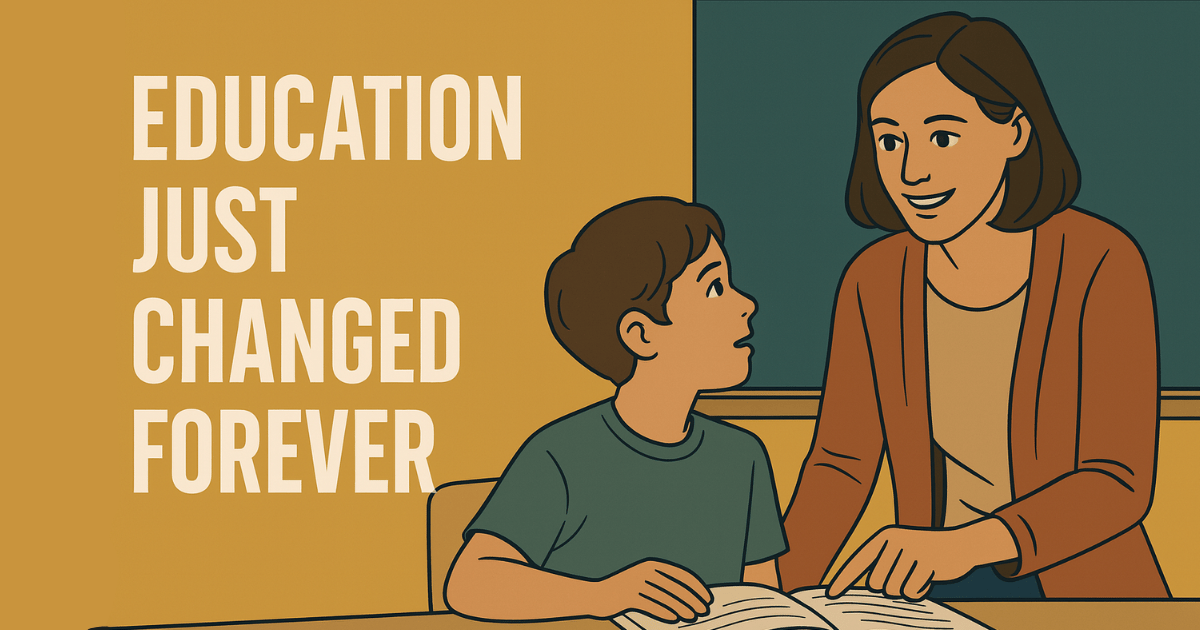- Future Proof Parent
- Posts
- Wait... Five assistants per classroom?
Wait... Five assistants per classroom?
Students, teachers and parents are gonna love it.

📌 Here’s what you’ll learn in today’s issue:
How AI could give every teacher five virtual assistants, and transform your child’s classroom experience
Why this tech shift could close learning gaps and end the “tutor advantage”
Two AI prompts to simplify back-to-school shopping (and reduce the arguments)
Waymo’s new teen accounts bring solo robotaxi rides to kids—with parents still in the loop
🧠 The Big Idea: The Classroom Just Got 5 New Teaching Assistants—And They’re All AI
What if your child’s overwhelmed teacher suddenly had five brilliant grad students by their side—ready to answer questions, review work, give feedback, and support every kid individually?
That’s the future Sal Khan says is already here.
The founder of Khan Academy just predicted that AI tutors—like his new GPT-4-powered Khanmigo—will soon give every teacher “four or five AI assistants,” dramatically transforming what’s possible in the classroom.
Imagine this:
A student gets stuck on a math problem. Instead of waiting for help, they turn to an AI that guides them—step by step—without just giving the answer.
Another is writing an essay. Their AI coach offers instant feedback: structure, grammar, even deeper questions to explore.
Meanwhile, the teacher is freed up to do what humans do best: build relationships, motivate, and support.
This isn’t a sci-fi fantasy. It’s already being tested in real classrooms—and early results are promising.
In one real-world trial, students in grades 3–9 used an AI math tutor for just two 30-minute sessions per week over eight months.
The result?
Learning gains on par with what they’d typically get from months of traditional instruction—proving that short, regular use of AI can deliver major academic results.
That’s more than a time-saver.
It’s a total developmental shift.
Because when kids get instant, personalized feedback right when they need it, they stay engaged.
They don’t shut down.
They learn how to think through problems instead of memorizing steps.
They build confidence, not just compliance.
It also means kids can move at their own pace—faster when they’re ready, slower when they need to—without feeling judged or falling behind.
And for the first time, every student—not just the lucky ones—can access the kind of responsive, one-on-one support that research shows is most effective for deep learning.
This is what AI in the classroom should look like: not replacing teachers or spoon-feeding answers, but amplifying the moments that matter most for your child’s growth.
And here’s why this matters now more than ever:
We’re in the middle of a global teacher shortage.
Kids are falling behind—especially in reading and math.
Teachers are burning out from overcrowded classrooms and constant pressure.
AI won’t replace them, but it can relieve them.
It can fill gaps, personalize learning, and give every student the kind of attention that was once only available to the rich.
Khan calls it a once-in-a-generation opportunity. A way to radically reduce inequality and finally deliver on the promise of personalized education for all.
But only if we get it right.
Because AI in education is a tool—not a teacher. Used passively, it becomes a crutch.
Used actively, it becomes a catalyst.
💬 Future Proof Parent PROMPTS of the Day
AI-Optimized Back-to-School Shopping
Back-to-school season will be here before you know it. And with it, the chaos of supply lists, clothing battles, and last-minute Target runs.
These two AI prompts can help you take the stress out of shopping by making your life easier, your kid more prepared, and your cart a whole lot smarter.
📝 School Supplies
Tired of forgetting stuff—or buying things your kid never uses?
Try this:
"Act as a school supply expert and create a back-to-school shopping list for a [grade level] student. Include must-haves, nice-to-haves, and optional tech tools. Keep it budget-friendly and organized by category."
🎽 Clothes + Style
Want to avoid fights over outfits—and still keep your kid looking sharp?
Here’s a prompt that makes fashion functional:
"Act as a personal stylist for a [age + gender] student going into [grade level]. Recommend a full back-to-school wardrobe, including basics, a few trendier items, and shoes—based on current styles, school rules, and Florida’s hot/humid weather."
Pro tip: Ask AI to give you links to specific items at your favorite stores (Target, Old Navy, Amazon, etc.) to make checkout a breeze.
🐝 What’s Buzzing for Mom & Dad Today
Big shifts are happening fast: from AI stepping into the co-parenting role to real concerns about how it's shaping our kids' creativity. Here’s what Future Proof Parents are digging into right now:
📵 YouTube Cracks Down on AI “Slop”
YouTube just announced it will limit monetization on mass-produced, low-effort AI videos — especially the kind flooding kids’ feeds. But the deeper issue? AI-generated junk content is everywhere, and platforms are still figuring out how to manage it.
See the update →
🛍️ Is AI Helping You Shop Smarter — or Spend More?
This Prime Day, AI-powered shopping tools are expected to explode in popularity. They promise better deals and personalized picks… but they’re also optimized to trigger impulse buys. Your cart isn’t just smart — it’s being manipulated.
Read the insights →
🚗 Waymo Launches Robotaxi Accounts for Teens
Teens in Phoenix can now ride solo in Waymo’s driverless cars, thanks to new parent-linked accounts with real-time tracking and safety features. The future of school pickups just got weirder — and way more high-tech.
See how it works →
📬 Like What You’re Reading?
Please forward this email to a parent who cares about preparing their kids for the future. Or send them to FutureProofParent.com to get our updates delivered straight to their inbox.
No fluff. No fear-mongering. Just clear, practical insights to help families thrive in an AI-powered world.